Neuropathic Pain
//eAbstracts
Enriched Population of PNS Neurons Derived from Human Embryonic Stem Cells as a Platform for Studying Peripheral Neuropathies
Journal: Plos One (February 18, 2010)
Authors: Valensi-Kurtz M, Lefler S, Cohen M, et al
Purpose: To create “a suitable cellular model” for studying peripheral neuropathies. Previous attempts at creating PNS cells from human embryonic stem cells would produce only low percentages. An increase in the amount of PNS cells is needed for future neuropathic study or investigation and by using a new method the researches would attempt to do so.
Results: The research team plated 8-week-old hESC-derived neural progenitors into laminin-coated dishes for two weeks, which then produced populations of functional PNS neurons with “electrophysiological activities typical of mature neurons.” The method also allowed the team, for the first time in human PNS neurons, to witness the expression of the protein that causes the peripheral neuropathy familial dysautonomia.
Link Code: pm3256
Chemical Composition and Evaluation of the Anti-hypernociceptive Effect of the Essential Oil Extracted from the Leaves of Ugni Myricoides on Inflammatory and Neuropathic Models of Pain in Mice
Journal: Planta Medica (February 2010)
Authors: Quintão N, da Silva G, Antonialli C, et al
Purpose: The essential oil from the leaves of Ugni myricoides contains six major constituents, including alpha-pinene, which demonstrate the plant’s systematic anti-hypernociceptive properties. This study focuses on orally administering the oil to mice to compare the effects with those of indomethacin or gabapentin in neuropathic pain relief.
Results: “U. myricoides essential oil produces marked anti-hypernociceptive effects in carrageenan and complete Freund’s adjuvant mechanical sensitization models, and also inhibited neuropathic pain-like behavior after partial ligation of the sciatic nerve with efficacy similar to that observed for indomethacin or gabapentin.”
Link Code: pm3257
//Clinical Trials
Neuropathic Pain Database NePDatabase
Study Type: Observational
Age/Gender Requirement: not specified (male/female)
Sponsor: Lawson Health Research Institute
Purpose: The study will serve to establish a national neuropathic pain database and determine the long-term outcome of the management of chronic neuropathic pain. The
database will provide information on demographics, diagnosis, treatment interventions, and outcome.
Link Code: pm3264
Intravenous Immunoglobulin as a Treatment for Resistant Neuropathic Pain
Study Type: Interventional
Age/Gender Requirement: 18 years (male/female)
Sponsor: University of Calgary
Purpose: This randomized, double-blind study is based on the findings that neuroinflammation may be involved in the development and maintenance of neuropathic pain. Researchers will explore “the effects of an immune-modulating blood-derived product, intravenous immunoglobulin (IVIG), in treating neuropathic pain. IVIG is thought to reduce neuroinflammation contributing to neuropathic pain.”
Link Code: pm3265
Nerve Localization in Diabetic Neuropathy
Study Type: Observational
Sponsor: University Health Network, Toronto
Age/Gender Requirement: 18-80 years (male/female)
Purpose: The study will compare nerve localization techniques and nerve characteristics in diabetic patients to those in healthy patients, as diabetics with neuropathy may be more susceptible to further nerve damage following regional anesthesia, and because nerve stimulation, the gold standard for nerve localization, can fail in diabetics.
Link Code: pm3266
//Online CME
Diabetic Neuropathy
Credits: 1.00
Fee: $25.00
Expires: March 7, 2011
Multimedia: Not listed
Upon completion of this course, participants should be able to discuss the epidemiological trends in diabetic neuropathies, recognize the different types of neuropathies affecting diabetic patients, and identify the basic approach to evaluation of a patient with diabetic neuropathy.
LinkCode: pm3232
//The Educated PatientTM
Nerve Pain Self-Care
Getting some exercise, taking a warm bath, or meditating are just a few activities suggested at this site for patients to help alleviate some neuropathic pain themselves. Although in most cases they won’t alleviate all types of pain, the tips offered here can be taken advantage of by patients on their own, accompanying their professional treatment regimen. The basics of neuropathic pain, including causes, are also reviewed.
Link Code: pm3222
